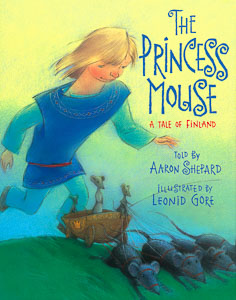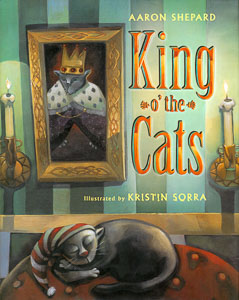~ AROUND THE YEAR WITH COOKIE MOLDS ~
January
New Year’s, Twelfth Night, and Storytelling around the Fire

Contents
New Year's, Twelfth Night, and Storytelling around the Fire
Recipe: Lemon Shortbread Cookie Tarts
Tip: Molding Shortbread
Story: Journey to the Twelfth-Night Market
Recipe: King Cookies (Spiced Lemon Pecan)
Story: The White Cat
Tip: Matching Cookie Recipes and Molds
Story: The Princess Mouse, a Tale of Finland
Recipe: Princess Mouse’s Layered Finnish Cookies
Tip: Adapting Recipes
Recipe: Mikko’s Rauma (Finnish Spice Cookies)
Tip: Removing Extra Flour from Molded Cookies
Tip: Buying Custom-Made Molds
Story: The Ropedancer
Tip: Allover Pattern Rolling Pin
Story: King o’ the Cats
Recipe: Chocolate Coconut Tea Cookies
Story: The Sea King’s Daughter
Recipe: Pryaniki (Plum Gingerbread Tarts)
Recipe: Lime Birthday Cookies
Tip: Making Irregular Shapes as Sandwich Cookies
January’s Cookie Molds
New Year’s, Twelfth Night, and Storytelling around the Fire
For most of the years I've lived in the Northwest, December has been the coldest, stormiest month. I tend to regard January as the beginning of the path to spring. However, it can still be very cold, and the days are still short. At the 49th Parallel, darkness comes early on a January evening.
The month begins with a feast, celebrating new beginnings and good intentions. Next, we celebrate the Feast of the Three Kings on January 6. This is Twelfth Night, the "twelfth day of Christmas," and a now little-observed tradition is that Christmas decorations should be removed on that day, and not before.
After that, the holidays are over, the Christmas lights no longer sparkle. But we have a new light—or an old one, for it goes back farther than history—storytelling around the fire. Or, in our case, the fireplace.
And stories are a form of light in themselves, because they call on the light of the imagination. They truly enlighten us—tell us who we are, and who we can be. Stories are one of the great powers in human history. The power of stories may be the source of the belief in magic.
And no time is more magical than the gathering of faces around the fire, and the first words of a story that binds them together. So join me for an evening of stories and cookies.
Recipe: Lemon Shortbread Cookie Tarts
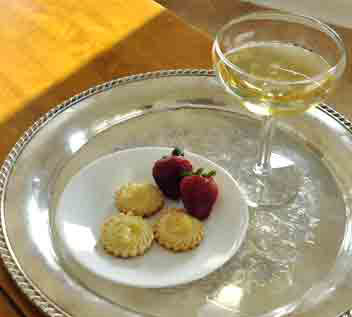
These are great New Year's cookies, especially if you serve them with champagne and strawberries! You'll find detailed directions for cookie tarts in the November issue of this magazine.
1 cup (225 grams) unsalted butter, softened
1/2 cup (100 grams) sugar
1 tablespoon honey
1 teaspoon freshly squeezed lemon juice
1 teaspoon finely-grated lemon peel
1/8 teaspoon culinary lemon oil
About 2-1/2 cups (350 grams) all-purpose flour (plain flour)
Lemon curd
Strawberries
1. Cream the butter, sugar, and honey.
2. Combine the lemon juice, lemon peel, and lemon oil and add to the butter mixture.
3. Add all-purpose flour slowly until the mixture is solid enough to knead.
4. Transfer to your work surface and knead in all but the last 1/4 cup (35 grams) of all-purpose flour.
5. Add up to the remaining 1/4 cup (35 grams) of all-purpose flour slowly and carefully, checking the texture of your dough as you go. Stop adding when the dough is still tacky but no longer sticks to your work surface.
6. When the flour amount seems right, wrap and set aside. Do not chill before molding.
7. I recommend molding and baking a test cookie to make sure your dough is correct. If you haven't added enough flour, the cookies won't hold an impression.
8. Preheat the oven to 300°F (150°C).
9. Bake the test cookie for 10 to 15 minutes or until the edges have slightly browned and the top has begun to firm up.
10. Examine the test cookie. If it has spread during baking and the design has become blurry, knead a little more flour into the rest of the dough and repeat the test.
11. When you have good results from the test, refrigerate the rest of the dough for up to 1/2 hour—until it’s firm but still flexible—then form and bake the rest of the cookies as instructed above.
12. Cool the cookies and spread the center of each thinly with lemon curd. Serve the berries alongside the cookies or top each cookie tart with a thin slice of strawberry.
Tip: Molding Shortbread
For most of my recipes, I've found that chilling before molding makes very little difference, maybe none. But for shortbread, there's a simple rule: don't chill before molding, period.
Here's what happens when you bake a cookie: The butterfat melts. The sugar melts. The flour and water have combined during mixing, and they become a solid structure. So do eggs, if any.
In shortbread, the water content of the butter combines with the flour to provide the structure. But the butterfat and sugar content is so high that the cookie will run if the dough was stiff enough to mold because the butterfat was chilled. You must add enough flour to make a molding consistency at room temperature.
If your cookies are small, as these cookie tarts are, you can make the cookies tenderer by using pastry flour, half cake flour and half all-purpose, or US Southern all-purpose flour such as White Lily. However, if you use a soft flour with a too-large cookie mold, the cookies will crack.
Story: Journey to the Twelfth-Night Market
By Anne L. Watson
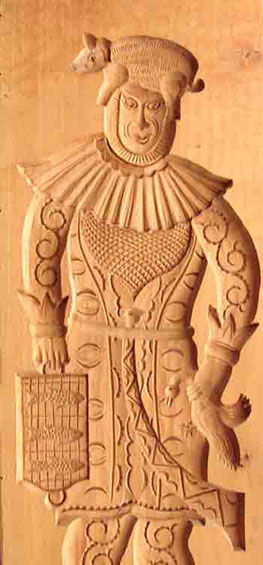
In a town not far from you, there lived a farmer who was a miserable man. His farm was prosperous, but his wife was bitter and his children were frightened, for he cared only for his farm and the wealth that came from it, and he was never kind to them at all.
He blamed them for their sorrow, for he believed that anyone could be happy if only they would. “They are whining fools,” he thought. “The wife and children of a poor man might have something to cry about. Mine live in comfort, but they cry anyway.”
“Smile!” he commanded his children. So they stretched their mouths, but they could not really smile, and he turned away in disappointment.
“Sing!” he commanded his wife. “Why do other men’s wives sing as they go about their work, but you do not?”
So his wife tried to sing, but her voice broke with tears, and he turned away in disgust.
Now it came time for the Feast of Twelfth Night, and the farmer took his wares to market, for it was the best market of the year. Surely, if he brought home a bag of gold, his wife and children would smile and sing.
“They would be fools if they didn’t,” he thought grimly.
So he set out with a goose he had killed, a basket of fresh-caught fish, and a suckling pig that had been only that morning with its mother.
The way to the market was dangerous, for many robbers lay in wait to catch a farmer with his wares on the way there, or with his bag of gold on the way home. And a dark, fast-flowing river ran between his farm and the market, and the fording of that river was a treacherous thing.
When he was halfway there, the goose struggled in his hand, and tears poured from its eyes.
“Let me go,” it said. “I never intended to give my life for a stranger’s dinner!”
The man was astonished, but he did not let go of the goose.
“A goose that can talk and cry will bring a fine price at the market,” said the farmer. “I would be a fool to let you go.”
“Let me go, and I will grant the wish of your heart,” the goose said.
The farmer was suspicious. “How can a goose know the wish of my heart, let alone grant it?”
“How indeed, if you do not know it yourself? But for a goose who can come back to life after you have wrung its neck, granting the wish of your heart is a small thing,” said the goose.
So the farmer let the goose go, and it flew off into the sky. “Of course I know the wish of my heart,” he thought. “I wish to escape the robbers as I journey to the market.” He walked on with a lighter heart, and he thought it was because he had no more need to fear the robbers.
Soon he came to the river. As he stood on the bank, his fish began to writhe in their basket, and tears poured from their eyes.
“Let us go!” they cried. “For we never intended to give our lives for a stranger’s dinner!”
The farmer was bewildered, but he did not put them into the river.
“Fish that can talk and cry will bring many bags of gold at the market,” he said. “I let the goose go, but I would be a fool to let you go.”
“If you let us go, we will grant the wish of your heart,” said the fish. “That is nothing, to fish that can drown in the air and still come back to life.”
The farmer considered their offer. If the goose had granted him safety from the robbers, surely the fish could bring him safe across the river. And the piglet would fetch a good price at the market, enough that his wife and children would have to smile and sing.
So he let the fish go, and they swam along the current. “Now I can cross the river and sell my piglet at the market,” the farmer said.
He put the piglet on his head and crossed the water easily. He walked on with a lighter heart, and he thought it was because he had no more need to fear the river.
But as he came to the market, the piglet began to squirm, and tears poured from its eyes.
“Take me home to my mother,” it pleaded. “I never intended to give my life for a stranger’s dinner. Take me home, and I will grant the wish of your heart.”
“I would be a fool to go home with empty hands,” said the farmer. “And I have no more fear of the robbers or the river, so you have nothing to offer me.”
“You have a hidden wish,” said the piglet. “And for a talking pig, granting a wish, even a hidden wish, is no great thing.”
The farmer considered this third offer.
“What is this wish?” he asked.
“Your hidden wish is to find what you have lost—the heart of the boy you used to be. When you released the goose and the fish, you thought your heart was lighter because you were safe from the robbers and the river.
“But you were wrong. Your heart was lighter because you showed mercy to the goose and the fish, and did not count their lives as money in your pocket. That was the wish they granted you, to regain part of yourself.
“Take me home to my mother, show mercy to me, and reclaim the rest of your heart. That is the gift you will bring your wife and children from the great market of Twelfth Night.”
So the farmer turned, and the piglet followed him home. The farmer’s children smiled and danced to see their father so changed, and his wife sang and laughed.
And the piglet returned to its mother and never spoke another word.
Recipe: King Cookies (Spiced Lemon Pecan)
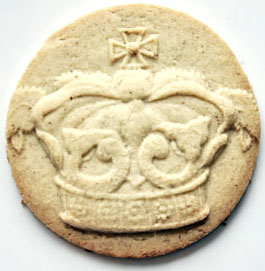
These cookies are based on “King Cake,” the traditional Twelfth Night dessert in New Orleans, where I grew up. Traditionally, a bean, coin, or favor is placed in the cake , and the person whose piece of cake includes the favor must host the king cake party the next year.
1 cup (225 grams) unsalted butter
1 large egg
1/2 cup (120 milliliters) honey
1 tablespoon freshly squeezed lemon juice
1 teaspoon natural lemon flavoring
1/2 cup (100 grams) sugar
2 teaspoons finely grated lemon peel
1 teaspoon cinnamon
1/2 teaspoon nutmeg
1/8 teaspoon salt
1/2 cup (80 grams) chopped pecans
About 4-1/2 cups (630 grams) all-purpose flour (plain flour)
1. Unless you're making a layered cookie, grind the pecans with one cup of the flour and set aside. (See note)
2. Melt the butter and set aside.
3. Beat the egg in a large bowl until the yolk and white are fully mixed.
4. Mix the honey, lemon juice, and lemon flavoring. Add to the egg and beat until well mixed.
5. Mix the sugar, grated lemon peel, cinnamon, nutmeg, and salt. Add to the egg mixture and beat until well mixed.
6. Add the melted butter slowly and beat until well mixed. Don’t just pour it in quickly—the heat still in the butter could cook the egg!
If you've ground the pecans with part of the flour, add that first.
8. Transfer the dough to a floured work surface. Continue adding flour by kneading in a little at a time until the dough is smooth and slightly sticky.
9. Wrap or cover the dough to prevent drying, then refrigerate to make it less sticky. This should take half an hour at most.
10. Roll and form the dough according to the directions for cookie tarts.
11. Refrigerate the cookies while you preheat the oven to 350°F (175°C), or lower for especially thick cookies.
12. Bake for 10 to 15 minutes or until the edges have slightly browned and the top has begun to firm up.
Chopped pecans won't look good on the surface of molded cookies, so you should either grind the pecans or make the cookies as layered cookies.
To make as a layered cookie, chop the pecans finely and add to the lower layer. For layered cookie directions, see the November issue of this magazine.
If you grind the pecans, combine them with one cup of the flour in a food processor with the steel blade and process until smooth. The reason for processing them with flour is to prevent them from being turned into nut butter, which will happen otherwise.
Story: The White Cat
By Anne L. Watson
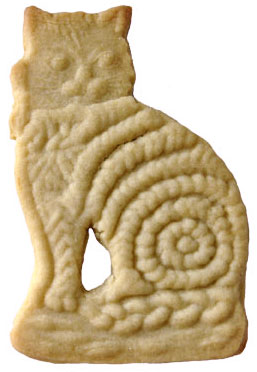
In a town not far from you, there lived an old grazier who owned many acres and a fine flock of sheep. He was not a bad man, not at all. But he had an enemy, and this enemy lived inside his mouth. And it often spoke harsh words to his wife and his young son.
The grazier’s unkind words did not come from his heart, but from whisperings of fear. His wife was a young woman, pretty and kind, and he saw no reason for her to love an old man whose best years were behind him.
As for the son, the grazier felt that sternness would raise him to stout manhood, while babying would only spoil him.
Often enough, he changed his mind, and saw his wife as the fine woman she was, and his son as a good boy with much promise. But he could not take back his hard words, for his enemy would not speak an apology. So he would take his son for an hour of playing with the lambs or buy his wife a silken ribbon for her hair.
His wife did not want hair ribbons, but she treasured them in a box at the bottom of a chest. Sometimes their soft brightness was her only reminder that her husband loved her. And this she wanted very much. So sometimes she would open the box and touch them, taking comfort from their beauty.
Now it happened one winter morning that the grazier was sullen and his wife was slow on her feet, for they both had been up most of the night with the lambing. They had slept fitfully, the little sleep they had, and risen later than usual, and a long day was ahead of them, with more lambs yet to be born.
The grazier looked over the breakfast she had hastily and tiredly prepared.
“No proper wife would set such a meal before her husband,” the enemy said. “I slept little enough last night, and have much work to do today. Surely you married me for my lands and flocks, for if you loved me, you would care about my well-being.”
He felt a pang even as the words fell from his lips, for his wife had shared the lambing vigil with him without complaint, and he saw the hurt his words had added to the tiredness in her face. But she did not answer.
She went about her morning chores with a heavy heart, wondering if in fact she did still love her husband. He was like a wind that blew—now from the north, now from the south, with no way of knowing where it would shift next. And her feelings for him had a feather’s balance—love and sorrow, sorrow and love, and she did not know what to do.
Fingering one of her precious ribbons in her pocket, she walked down the lane to the great road that ran to the town. She pulled her shawl close around her against the winter wind, and sat on a rock that made a natural seat beside the road.
Her thoughts stumbled and whirled. First she thought it would be best to leave the grazier forever, but she instantly changed her mind. For she did love her husband, and she knew he was not a bad man, however bitterly he might speak in his dark moods. And to abandon her child was something she could not do, but there was no way to keep the boy safe if she took him with her along the great road.
Snow lay on the verges, and at first she did not notice the white cat, even though it sat close by. When she did, she realized it was preparing to leap across the road in pursuit of something in the hedge on the other side. And at the same time, she heard a cart coming fast along the road, and she was sure the cat, intent on its leap, would be crushed by the horses’ hooves and the pounding wheels.
She reached out a hand and gently held the cat as the cart passed by. It turned and looked at her with bright blue eyes, and she knew it must be deaf, for many cats with that coloring cannot hear at all.
When the cart had passed, she released it, but it did not cross the road. It regarded her for a moment with a deep, bright blue stare, meowed once, and turned back the way it had come. She watched it as it disappeared into the snowy landscape. And then she returned to her house, determined to do the best she could to bear her husband’s churlishness, if only for the sake of her child.
But from that day forward, she could not hear any unkind word. Each time her husband’s enemy spewed abuse, she was as deaf to it as a blue-eyed cat. What she heard instead was animal cries—the wild bleating of lambs or the shrieks of frightened chickens.
“My dear,” she would say, “We must go to the sheep, for there is surely a wolf in the yard.” Or “My dear, we must see to the chickens, for the wolf must be among them.”
And they would rush to care for the animals, and return puzzled, for they found nothing, not even tracks in the snow near the barns.
“I saw nothing,” he said one day as they returned to their house after yet another commotion.
“Nor I,” she said. “Perhaps the animals heard a wolf caught in a trap.”
The grazier’s enemy was desperate, for without being fed by hurt, it must starve. So it tried its might against the boy, but he, too, heard only animals yammering with fear.
“Father, the wolf is here again,” he cried. And the grazier rushed to defend his sheep, and again he found nothing, not even tracks in the snow near the barns.
Finally, the grazier’s enemy had none to abuse but him. So, alone in the house one day, the grazier spoke his venom to himself. But all he could hear was a distant howling, and looking in a mirror, he saw a maddened wolf, snarling in a trap.
Then he took his handkerchief from his pocket, and spat his wizened enemy into it. He laid the handkerchief on the fire, and it flared and burned to an ash and less than an ash. And instantly the mirror showed him a man who was not a bad man, not at all.
That was the end of the enemy, and of the cries and uproar in the grazier’s yards. His wife and son forgot his unkindness as if it had never been. And the silken ribbons were forgotten too, in their box at the bottom of the chest, for his wife had no need to look anywhere but his face for reasons to believe he loved her.
Tip: Matching Cookie Recipes and Molds
When you make molded cookies, it's important to think about the match between your recipe and the mold you want to use.
Cookie recipes make dough that varies in color, texture, and "pattern"—that is, whether it has speckles of color. It also varies in how tender the cookie is after it's cooked.
Making sure you have a good match between the cookie and the mold is one of many reasons why it's a good idea to bake a test cookie.
Color
The things that add color to dough are fairly obvious—chocolate, cocoa, coffee, spices, etc. Almost all are strong flavors, and you want them for that. But, if you use them in your dough, you have to choose a cookie mold that isn't too small or delicate in pattern. A larger, more deeply cut cookie mold will give you a prettier cookie with a dark dough. One thing to realize, though, is that the dough is going to be darker than the baked cookie, because quite a bit of liquid bakes out of the cookie.
Texture
Some ingredients like chocolate chips, chopped nuts, dried fruit, or oatmeal, just don't marry well with cookie molds. You need a smooth, dense surface to print the pattern of a mold. If you want these ingredients, you can make layered cookies, as I describe in my book, Baking with Cookie Molds. Or you can make sandwich cookies or cookie tarts with the special ingredients in the filling. Or you can grind nuts replace part of the flour with them. If you use dried fruit, even in layered cookies, it must be chopped much finer than you'd expect, because it will re-hydrate and enlarge once it gets into the dough. Of course, you might re-hydrate it with brandy or other flavoring before you put it into the dough, then chop it. I haven't tried this, but it would probably work, with a little experimentation.
Pattern
Some ingredients like maple sugar or spices may make speckles in the dough. This works fine with some molds, not with others. A flower with dark speckles is likely to look as if it has Black Spot. Faces might look strange. But geometric patterns or animals won't seem odd with speckles. This is also a matter of scale—a large speckled figure might look fine, where a close-up of a face might not.
Tenderness
The more tender a cookie is, the smaller it must be to hold together. Tenderness is affected by the kind of flour you use—softer flours such as cake flour, pastry flour, or Southern US all-purpose flour, will make tenderer cookies. Butter and sugar proportions also affect tenderness. So does use of honey—when I make enormous cookies, I use 100% honey rather than half sugar and half honey. They're harder and denser than all-sugar cookies.
Handling also affects tenderness. The more you knead dough, the tougher it will be.
I always make shortbread with soft flour, and I use tiny molds. For most other cookies, there's a wider range. Most molds can tolerate a variety of color, texture, and pattern.
I wouldn't use extra soft flour for any cookie over an inch or so in any dimension. For those over eight inches, I'd use 100% honey. I'm not saying it couldn't work to break those rules, but I like to make things easy on myself.
Story: The Princess Mouse, a Tale of Finland
My husband, Aaron Shepard, is a children’s author who re-tells folktales of many countries. This story from Finland is about a young man named Mikko who finds his bride in an unusual way. And the bride he finds is an unusual bride.
Click on the book cover to read the story on Aaron’s web site.
Recipe: Princess Mouse’s Layered Finnish Cookies
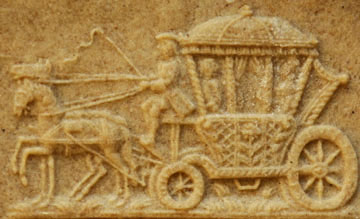
This isn’t a traditional cookie recipe from Finland. Instead, I've used the flavors of Pasha, a Finnish dessert usually served at Easter. Since raisins are traditional in this dessert, we'll make the cookies in layers, with raisins in the lower layer.
The cookie is mild flavored, somewhat similar to a Garibaldi. If you want a stronger flavor, increase the spices and flavorings and add finely grated orange rind to the lower layer along with the raisins.
1 cup (225 grams) unsalted butter
1 large egg
1/2 cup (120 milliliters) honey
1 tablespoon cream
1 teaspoon natural lemon flavoring
1/2 teaspoon natural orange flavoring
1/4 teaspoon almond extract
1/2 cup (100 grams) sugar
1/2 cup (80 grams) ground blanched almonds—see note
1/2 teaspoon ground ginger (or 2 teaspoons grated fresh ginger)
1/4 teaspoon ground cloves
1/2 teaspoon ground cinnamon
1/4 teaspoon salt
1/2 cup (75 grams) chopped raisins
About 3-3/4 cups (515 grams) all-purpose flour (plain flour)
1. Melt the butter and set aside.
2. Beat the egg in a large bowl until yolk and white are fully mixed.
3. Mix the honey, cream, lemon flavoring, orange flavoring, and almond extract. Add to the egg and beat until well mixed. If you're using fresh ginger, add it to this mixture.
4. Mix the sugar, ground almonds, ground ginger, cloves, cinnamon, and salt. Add to the egg mixture and beat until well mixed.
5. Add the melted butter slowly and beat until well mixed.
6. Add flour slowly until the mixture is solid enough to knead.
7. Transfer to your work surface and knead in more flour to make a soft, slightly sticky dough.
8. Form cookies according to directions for layered cookies in the November issue of this magazine or in my book, Baking with Cookie Molds.
12. Refrigerate the cookies while you preheat the oven to 350°F (175°C), or lower for especially thick cookies.
11. Bake for 10 to 15 minutes or until the edges have slightly browned and the top has begun to firm up, longer for extra-large cookies.
Blanched almonds are almonds with the brown skins removed. It’s not necessary to blanch them, but your cookies will be quite speckled if you don’t. You may be able to find them already ground, or you can mix the almonds with one cup of the flour and process in a food processor with the steel blade. The flour keeps the almonds from turning into almond butter in the processor. If you grind the almonds with part of the flour, add right after you add the butter, and before the rest of the flour.
If you want to blanch your own almonds, you can find instructions online. It’s easy but a bit messy.
To chop raisins, sprinkle a little flour on them. This will keep them from sticking to your knife. I've tried chopping them in a food processor, but even with the flour, a knife does a better job.
Tip: Adapting Recipes
You can adapt molded cookie recipes to recall the flavor of any national cuisine, as I did with Princess Mouse’s Layered Finnish Cookies. Look up recipes for desserts and sweets from a particular nation or culture, and notice the spices, variations of sugar, and other prominent flavors such as nuts, raisins, citrus, or chocolate. Then take a simple molded cookie recipe and add those flavors.
Of course, your flavors don’t have to have a national theme. You could choose flavors that you simply like together. One book that I highly recommend for choosing flavors is The Flavor Bible: The Essential Guide to Culinary Creativity, Based on the Wisdom of America's Most Imaginative Chefs, by Karen Page and Andrew Dornenburg. I’ve used it with great success.
Recipe: Mikko’s Rauma (Finnish Spice Cookies)
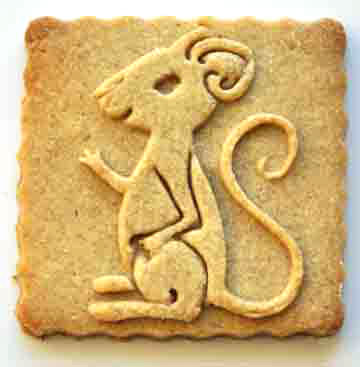
The flavor is somewhere between snickerdoodles and graham crackers. Because of the graham flour, this dough is more inclined to stick to molds than most. Flour the rolled out dough more heavily than most, and see the tip below for removing any stray bits of flour from molded dough.
If you have difficulty getting a smooth surface for molding, brush a little flour on the dough and roll it in. Then flour again and mold the cookies.
1 cup (225 grams) unsalted butter
1 large egg
1/2 cup (120 milliliters) honey
1 tablespoon cream
1 teaspoon brandy flavoring
1/2 cup (100 grams) dark brown sugar
1/2 teaspoon ground cinnamon
1/2 teaspoon ground mace
1/4 teaspoon ground cloves
1/8 teaspoon ground cardamom
1/4 teaspoon salt
1 cup (120 grams) graham flour or whole wheat flour
About 4-1/2 cups (630 grams) all-purpose flour (plain flour)
1. Melt the butter and set aside.
2. Beat the egg in a large bowl until yolk and white are fully mixed.
3. Mix the honey, cream, and brandy flavoring. Add to the egg and beat until well mixed.
4. Mix the brown sugar, cinnamon, cloves, mace, cardamom and salt. Add to the egg mixture and beat until well mixed.
5. Add the melted butter slowly and beat until well mixed.
6. Add graham flour slowly, then add all-purpose flour until the mixture is solid enough to knead.
7. Transfer to your work surface and knead in more all-purpose flour to make a soft, slightly sticky dough.
9. Roll and form the dough according to the directions for your cookie mold.
10. Chill the cookies while you preheat the oven to 350°F (175°C).
11. Bake for 10-15 minutes or until slightly browned at the edges.
Tip: Removing Extra Flour from Molded Cookies
Some doughs just want to stick to your molds. One way to get around this is to brush flour fairly heavily on the dough surface before molding. "Fairly" heavily doesn't mean you have a whole layer of flour, but that you can see it clearly—it isn't just a whitish veil.
But if you do use extra flour, what's likely to happen is that you'll unmold the cookie and find that it's perfect except that there are some white spots on it. Don't panic.
The first thing to do is just set the cookie aside for about fifteen minutes at room temperature. Some or all of the flour is going to disappear. If any is left, you can remove it with a lightly oiled artist's brush, either before or after baking. If there's still quite a bit, try freezing the cookie solid and then removing the flour with a lightly oiled artist's brush.
And finally, you can use that same brush to remove flecks after baking.
Of course, this is for fairly minor cleanup—a cookie that has a few spots. If you have flour all over the cookie, you'll have to do it over.
Tip: Buying Custom-Made Molds
You might want a personalized mold, or one with a custom image, like the mouse above. A few cookie mold makers will make these, although the cost is several times that of a comparable ready-made mold. The makers I know of who do make custom molds are
If you are another cookie mold maker who does provide this service, please use the contact form on this web page to let me know, and I'll add you to the list.
Story: The Ropedancer
By Anne L. Watson

In a town not far from you, there lived a widow who fretted greatly about her only son. He was a handsome boy, with golden hair and a bright smile, and he was a good boy, too. He meant to be no trouble to his mother, but the two of them might have been from different countries, so unlike were they.
The widow owned a fine bakeshop that she had from her late husband, and she counted on her son to follow in his father’s path, learn to make bread and pastries, and take care of her in her old age.
Since his mother had no other children, the boy understood that her future was in his hands, but it was a great trouble to him. For he had little skill at baking and little interest in learning the trade. And, try as he might, he could hardly conceal his feelings.
She tried to graft her skill into his hands, her love of good baking into his mind. But bread knows when a baker does not care about it. There was nothing really wrong with his loaves, but there was nothing very right with them either. They were discouraged loaves, and they discouraged those who ate them instead of making them stronger.
She thought he might marry a girl with a better hand for baking, and for a long time she hoped he would turn his eye to the neighbor’s daughter, a fine young girl who often helped in the bakery. She had the hand for bread, and for pastry too, and the widow knew her shop would thrive beyond the next generation if her son married the neighbor’s daughter.
But one year her son came home from the fair with a light in his eyes, and stories about a man who juggled and danced on a rope. And her heart sank, for this was no profession for a widow’s only son. She said nothing as his baking became worse than before, and she held her tongue when she saw a rope stretched between two trees in the wood behind their house. When he limped into the bakeshop with his ankle bound up one morning, she hoped pain had taught him a lesson about rope dancing. But she could see in his face that, however little his body might be able to follow them, his dreams were dancing and spinning on a rope high above a crowd.
She sighed, for she knew about dreams. Her father had opposed her marriage because her chosen husband was a baker, a tradesman, not a landowner. She knew that arguing with someone else’s dream was as fruitless as arguing with one’s own. She hoped her son would forget dancing and juggling if she said nothing. The acrobats were gone, and she hoped they would never come back. He would surely forget.
He might have, for he had no teacher. But one day, as he stood outside the bakery with the neighbor’s daughter, a songbird came near them, pecking the ground for crumbs. And the girl flapped her apron at the bird to shoo it away.
“Why do you do that?” the boy asked, laying a hand on her arm to stop her.
“The birds are dirty,” she said. “The come for the crumbs, but they quarrel and soil the path, and I do not like them here.”
“Surely, everyone must eat,” he said. “But if you prefer, we will put a feeder in the back garden. For we have crumbs enough for a thousand birds, and where else should they go?”
The girl was surprised, but she agreed that birds in the back garden would not be a bad thing. So he built a feeder for them and kept it filled with crumbs.
When he next struggled with his ropewalking, he noticed a bird sitting on a branch near him. After he had fallen once or twice, the bird spoke up:
“Bend your legs a little,” it said. “Keep the rope at the center of your foot, and look out, not down.”
The boy had never heard a bird talk, but after a moment of surprise, he realized that a bird would know far more about walking on a line than any man. So he took the bird’s advice, and soon he could walk easily on the rope.
He had little time, though, and it galled him to have to leave the bird and return to his endless baking. But when he next came to practice, he found another bird, and another, and among them, they taught him to walk on the line, and to turn and dance as well, so that he lacked nothing in skill. And he saw he could go and make his fortune with the juggler folk, and that he had no more reason to be a baker, save one.
That was his mother, and he knew he must leave her in peace and safety or he could not leave at all. So he begged the neighbor girl to be a daughter to her, and to learn all the business of the shop, and never leave.
“Your talent is greater than mine,” he said. “And my mother needs you.”
“I will do it,” she promised. “For no one else does need me. And your mother has been like a mother to me.
“And besides,” she added, “I love making the loaves, and the sweets, with the fine smell of wheat and spices. Being the daughter of the bakeshop is my dream come to waking.”
Then the boy told his mother what he planned to do. At first she wept, but soon she realized that her new daughter was a much better heir for her business than ever her son could be.
“You must come back sometimes,” she said. “You must let us see you, and hear of your life, or we will fret about you night and day.”
He promised to do this whenever he could. And he also asked the girl to keep the feeder full for the birds, winter and summer, for it made him sad to think they might go hungry. And this she promised. So he left to seek his fortune with the jugglers.
Now, whether he became a famous ropedancer, the story does not say. Nor whether he traveled to many lands, or if he performed for kings and queens. It may well be, for all who saw him marveled that he danced so like a bird, it seemed he might well fly.
But it is known that he kept his promise to come back from time to time, and that he did all he could for his mother for as long as she lived. The neighbor’s daughter welcomed him when he came as she welcomed the birds to the well-filled feeder behind the house. And, when the time came for him to go, the girl showed no more surprise or reproach than when the birds flew away.
There are those who believe he returned to stay, in the end. For in later years, an old man could be seen, teaching a golden-haired child to walk on a rope in the woods behind the house, while the neighbor’s daughter, now an old woman, kneaded her wonderful bread in the kitchen behind the bakeshop. But whether it was the ropedancer at all, or whether the child was his, no one would ever know.
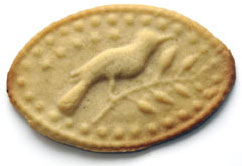
Tip: Allover Pattern Rolling Pin
When you’re making layered cookies, you can’t re-roll the dough and keep the layers. So you want to get as many cookies as possible out of the first rolling. My favorite cookie mold for this is a springerle rolling pin with an allover pattern. Besides working so well for layered cookies, these are great for making a lot of molded cookies quickly.
Here’s mine, an antique.

And here’s one from House on the Hill. The pattern's a little more structured than the pattern of mine, but I think it would work just as well.
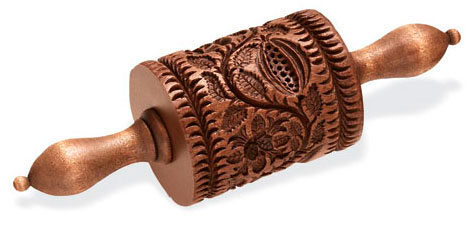 .
.
When you’ve rolled your dough, and stacked the two layers, you flour the top lightly, make an allover design on it with one of these rolling pins, and then cut it into cookies, either with shaped cookie cutters—I use a fluted rectangle—or with a pastry wheel.
Story: King o’ the Cats
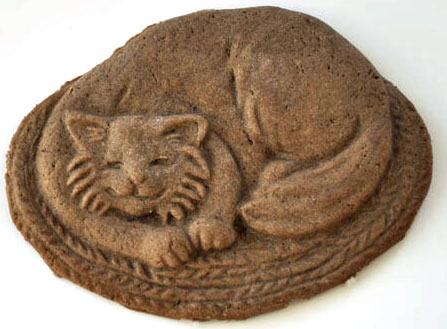
Our storytelling evening stretches out with a spooky story, also from Aaron Shepard. This one is about a cat who . . . isn’t quite what he seems, and two men of the town of Tabby-on-Thames who learn that truth really can be stranger than fiction. Much stranger.
Click on the book cover to read the story on Aaron’s web site.
Recipe: Chocolate Coconut Tea Cookies
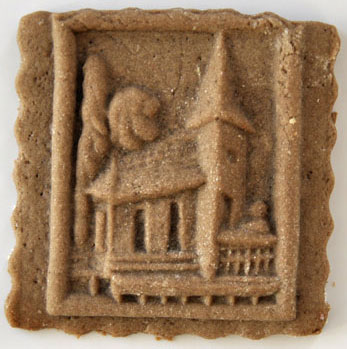
The story "King o' the Cats" is from England, so we’ll have English tea cookies to go with it—as served on Tabby-on-Thames.
The flavor is mostly like hot cocoa, with a more subtle coconut taste. For stronger chocolate flavor, make these as cookie tarts with a chocolate filling (see below for filling suggestions), use the chocolate backing recipe from my bookBaking with Cookie Molds, or make as a layered cookie with mini chocolate chips in the lower layer. If you add a chocolate backing, you could flavor it with coconut extract as well.
Although the dough is quite dark, the finished cookies are about the color of cocoa, which means that the details of your molds won't be lost.
1/2 cup (115 grams) unsalted butter
1 large egg
1 cup (235 milliliters) canned cream of coconut (See notes.)
1 tablespoon coconut extract
1 teaspoon chocolate extract
1/2 teaspoon vanilla
1/2 cup (100 grams) sugar
2 tablespoons cocoa
1 teaspoon cinnamon
1/4 teaspoon salt
About 4-1/2 cups (630 grams) all-purpose flour (plain flour)
1. Melt the butter and set aside.
2. Beat the egg in a large bowl until yolk and white are fully mixed.
3. Mix the cream of coconut, coconut extract, chocolate extract, and vanilla extract. Add to the egg and beat until well mixed.
4. Mix the sugar, cocoa, cinnamon, and salt. Add to the egg mixture and beat until well mixed.
5. Add the melted butter slowly and beat until well mixed.
6. Add flour slowly until the mixture is solid enough to knead.
7. Transfer to your work surface and knead in more flour to make a soft, slightly sticky dough.
8. Wrap or cover the dough and refrigerate for up to half an hour—until it’s firm but still flexible.
9. Roll and form the dough
10. Refrigerate the cookies while you preheat the oven to 350°F (175°C), or lower for especially thick cookies.
11. Bake for 10 to 15 minutes or until the edges have slightly browned and the top has begun to firm up.
Cream of coconut is a sweetened mixture used in drinks and desserts. It is not to be confused with coconut cream, which is unsweetened. Like natural peanut butter, cream of coconut tends to separate, so stir to blend well before measuring.
Filling suggestions for cookie tarts: chocolate buttercream frosting or chocolate almond butter.
Story: The Sea King’s Daughter

This is a fine story for the finale of our evening around the fire—it’s a story about venturing out and coming home. Sadko, a musician is summoned to play for the Sea King. The king rewards him richly—but what will Sadko’s adventure cost him? Read Aaron Shepard’s story to find the answer.
Click on the book cover to read the story on Aaron’s web site.
And here are a couple more cookies to go with the story.
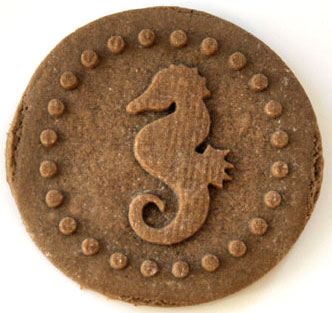
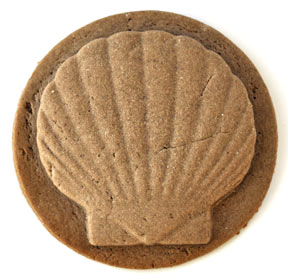
Recipe: Pryaniki (Plum Gingerbread Tarts)
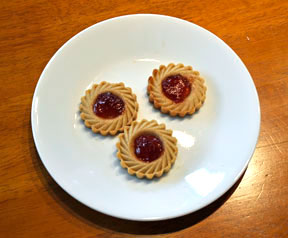
Here are some cookies for the Sea King's feast!
1 cup butter
1 egg
1/2 cup honey
1 tablespoon cream
1/2 teaspoon natural lemon flavor
1/2 tsp vanilla extract
1 tablespoon freshly grated ginger root
1/4 cup (50 grams) granulated sugar
1/4 cup (55 grams) brown sugar
1 teaspoon ground ginger
1 teaspoon ground cinnamon.
1/2 teaspoon ground nutmeg
1/2 teaspoon ground allspice
1/8 teaspoon salt
About 4-1/2 cups (630 grams) all-purpose flour (plain flour)
1. Melt the butter and set aside.
2. Beat the egg in a large bowl until yolk and white are fully mixed.
3. Mix the honey, cream, lemon flavoring, vanilla extract, and grated ginger root. Add to the egg and beat until well mixed.
4. Mix the granulated sugar, brown sugar, ground ginger, cinnamon, nutmeg, allspice, and salt. Add to the egg mixture and beat until well mixed.
5. Add the melted butter slowly and beat until well mixed.
6. Add flour slowly until the mixture is solid enough to knead.
7. Transfer to your work surface and knead in more flour to make a soft, slightly sticky dough.
8. Wrap or cover the dough and refrigerate for up to 1/2 hour—until it’s firm but still flexible.
9. Roll and form the dough according to the directions for cookie tarts.
10. Refrigerate the cookies while you preheat the oven to 350°F (175°C), or lower for especially thick cookies.
11. Bake for 10 to 15 minutes or until the edges have slightly browned and the top has begun to firm up.
Filling: A traditional filling for Pryaniki would be plum jam. If you like, mix the jam with cream cheese, plum liqueur, cinnamon, or lemon flavoring. Or all four.
Recipe: Lime Birthday Cookies
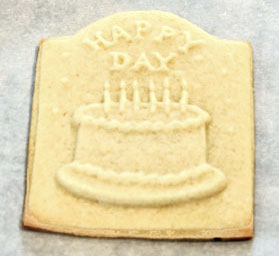
My birthday is in January, and my favorite flavor is any fruit flavor. When I was a child, my mother worked out a lime cake for my birthday, since most other fruits weren’t available in midwinter. Here’s a cookie that recreates the flavor. I like it best as either a cookie tart or a sandwich cookie with lime curd filling. I've used several different lime flavors here: culinary lime oil and powder as well as the more easily available juice and rind. If you want, you may increase the juice and rind amounts and omit the oil and powder.
1 cup (225 grams) unsalted butter
1 large egg
1/2 cup (120 milliliters) honey
1 tablespoon freshly squeezed lime juice
1 teaspoon freshly squeezed lemon juice
1 teaspoon natural lemon flavoring
1/8 teaspoon natural lime oil
1/2 cup (100 grams) sugar
2 teaspoons finely grated lime peel
1 teaspoon finely grated lemon peel
1/8 teaspoon salt
About 4-1/2 cups (630 grams) all-purpose flour (plain flour)
1. Melt the butter and set aside.
2. Beat the egg in a large bowl until the yolk and white are fully mixed.
3. Mix the honey, lime juice, lemon juice, lemon flavoring, and lime oil. Add to the egg and beat until well mixed.
4. Mix the sugar, lime peel, lemon peel, and salt. Add to the egg mixture and beat until well mixed. If the mixture isn’t smooth, don’t worry—it will become smooth as you add the flour.
5. Add the melted butter slowly and beat until well mixed. Don’t just pour it in quickly—the heat still in the butter could cook the egg!
6. Add flour slowly and mix in until you have dough that is solid enough to knead.
7. Transfer the dough to a floured work surface. Continue adding flour by kneading in a little at a time until the dough is smooth and slightly sticky.
8. Wrap or cover the dough to prevent drying, then refrigerate to make it less sticky. This should take half an hour at most.
9. Roll and form the dough according to the directions for your cookie mold.
10. Refrigerate the cookies while you preheat the oven to 350°F (175°C).
11. Bake for 10 to 15 minutes or until the edges have slightly browned and the top has begun to firm up.
Tip: Making Irregular Shapes as Sandwich Cookies
Sandwich cookies are easy if your cookie mold is round or square, or if it comes with its own cutter, as a few do. But what do you do if you want to make a sandwich cookie with an irregular-shaped mold?
Easy! Bake one cookie from your mold. Lay it on a sheet of parchment paper or thin plastic, and trace around it with a pencil.
Cut about 1/16 inch inside the line. The cookie will expand a tiny bit as it bakes, so you want your pattern to be very slightly smaller than the cookie.
Now you have a template.
Using a sheet of nonstick foil for backing, roll out the dough you want to use for the bottom layer of the cookie. Chill it thoroughly and, using your template, cut out each cookie back with a sharp knife such as a craft knife. Remove the scraps and bake the cookie back as a test cookie to make sure the size is right.
Correct if necessary, and cut and bake enough cookie backs to make sandwiches with your molded cookies. You can trim the cookie backs slightly while they're still warm, if needed to fit the tops.
Just before serving, assemble the backs and tops with a filling.
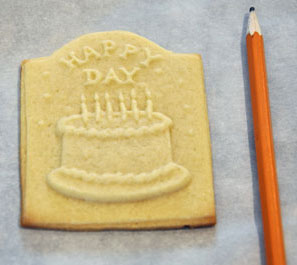
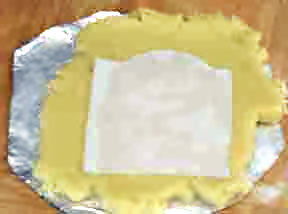
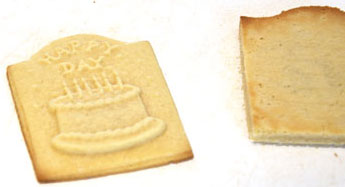
January’s Cookie Molds
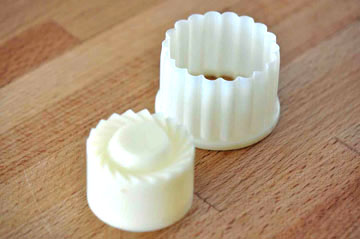
Tart mold from Brown Cookie

Cookie mold hand carved by Jan Vande Voorde
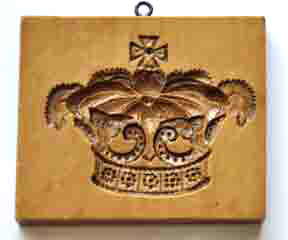
Crown cookie mold by House on the Hill
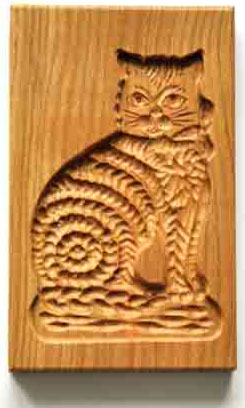
Cat cookie mold by HOBI Cookie Molds
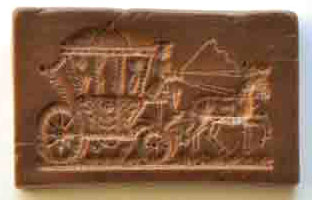
Small Wedding Coach by The Springerle Baker

Mouse cookie mold custom made by My Cookie Mold
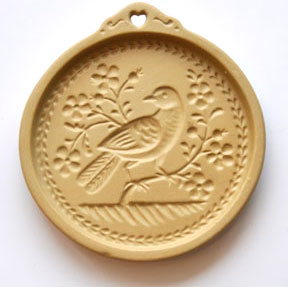
Meadowlark Mold by Brown Bag Cookie Molds
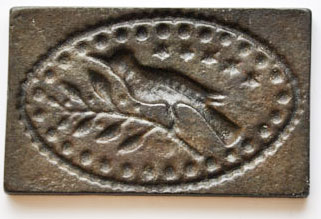
Antique cast iron bird cookie mold
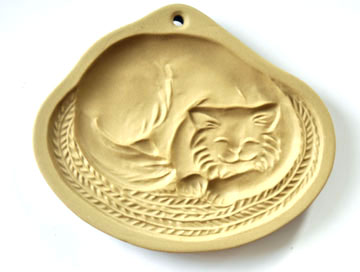
Sleepy Cat cookie mold by Brown Bag Molds
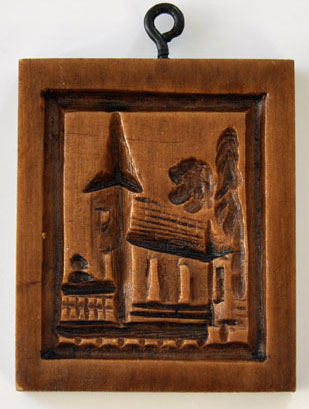
Country Church cookie mold by House on the Hill
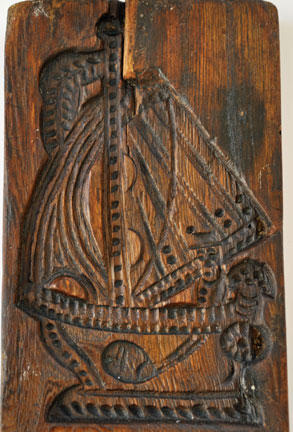
Antique Dutch ship cookie mold
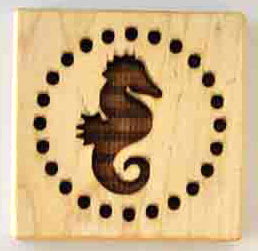
Seahorse cookie mold by My Cookie Mold
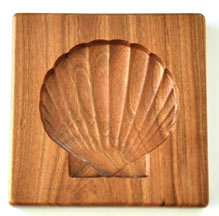
Shell cookie mold by Cherry Cookie Molds
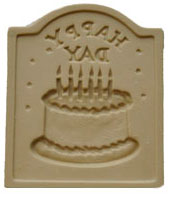
Birthday Cookie Tile by Brown Bag Molds



